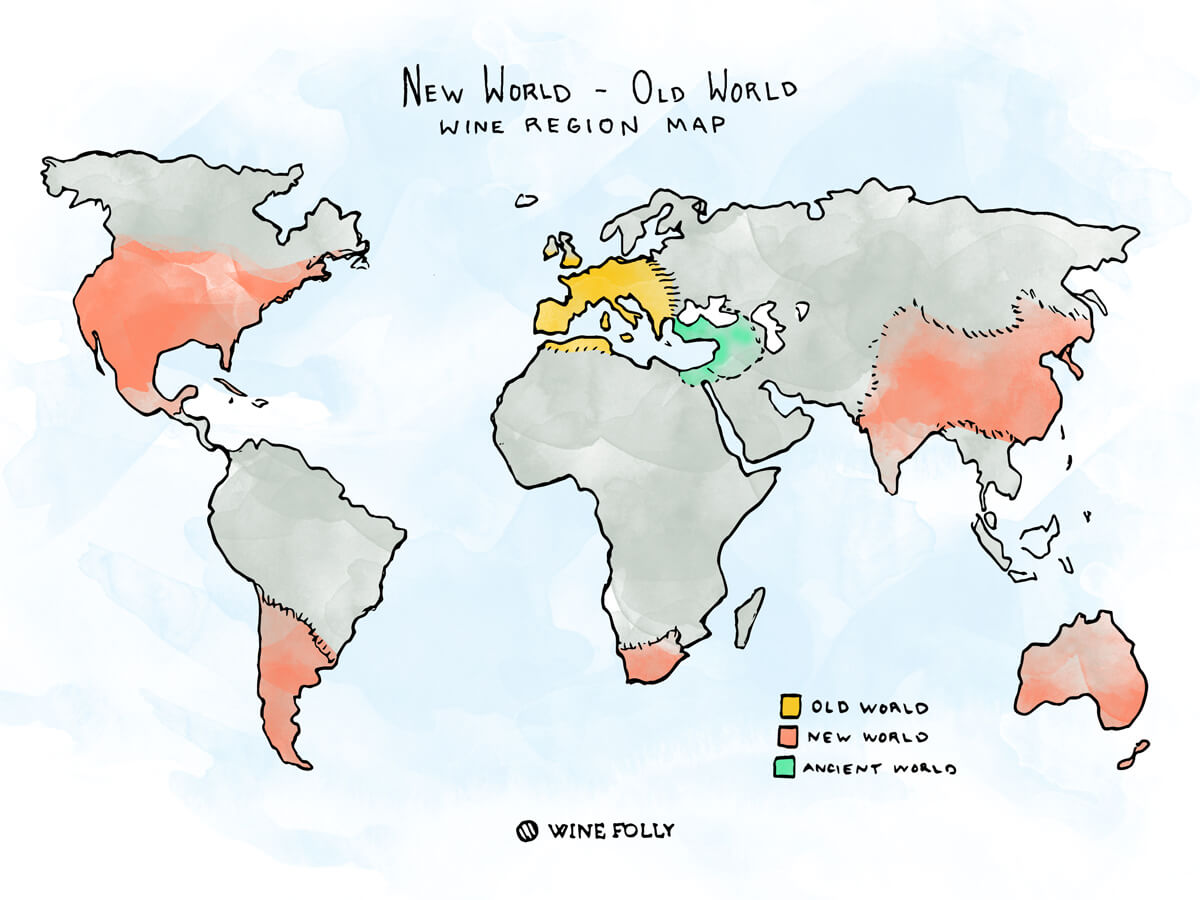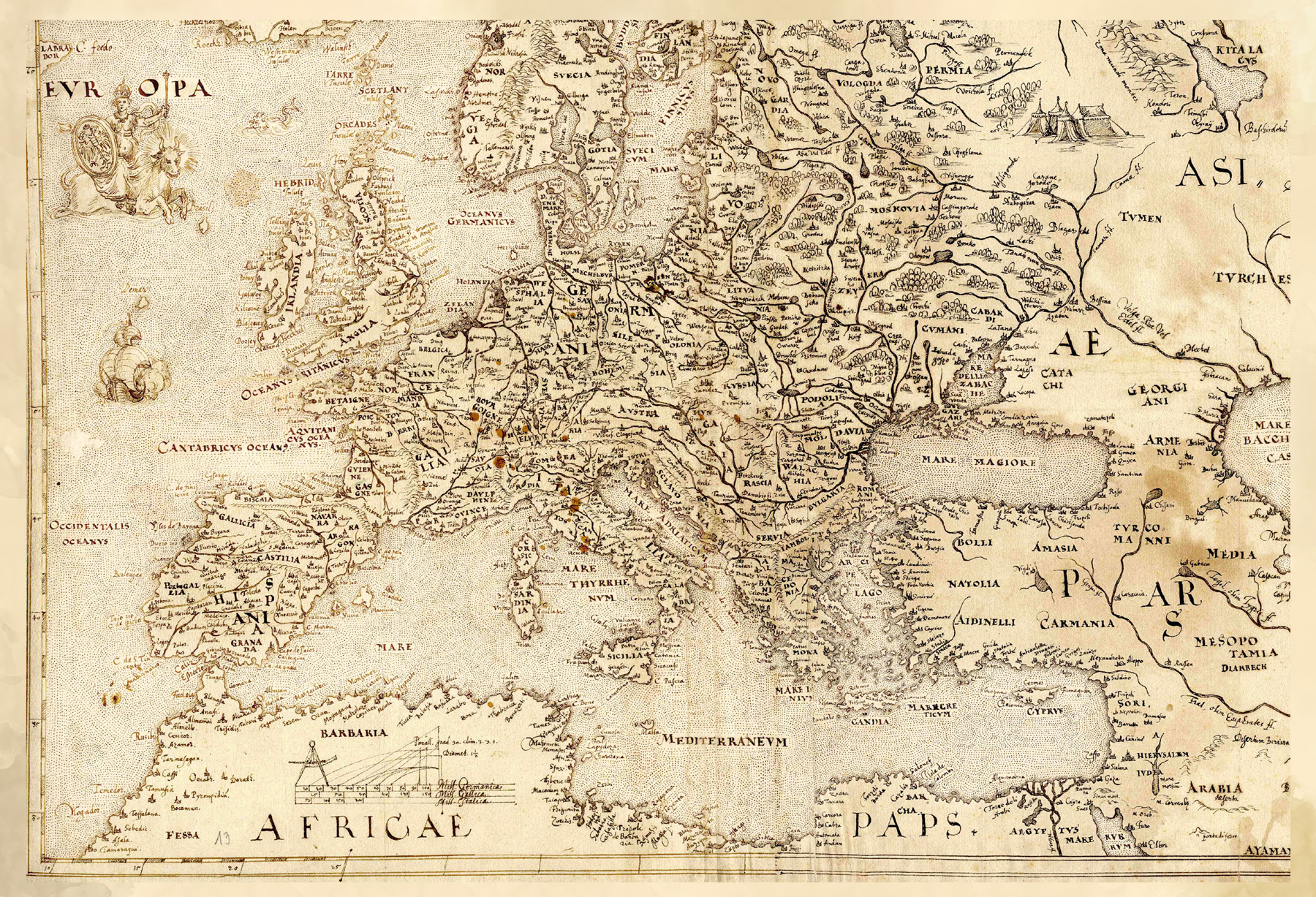People often describe wine as new world and old world.
That’s strange, how can a wine taste “old world?”
Recently, the Court of Masters Sommeliers announced they would no longer be using the terms in blind tastings.
Originally, it served to describe a specific taste in wine. Let’s get down to the origin of what these terms tell us about wine that you can suss out in your glass.
It turns out, that’s it’s not about “worlds” as much as it’s about tradition.

New World vs Old World: What’s the Difference?
In broad strokes, it comes down to winemaking traditions.
Old World vs. New World Wine Taste
These characteristics are typical, but by no means a rule.
Old World wine tends to have lighter body, lower alcohol, higher acidity, and less fruity flavor with more minerality.
New World wine tends toward fuller body, high alcohol, lower acidity, and pronounced fruit flavors.
Of course, this is almost like the difference between cool climate and warm climate wines.
But it’s not that cut and dry. Italy is Old World, but there are some hot spots there making rich, fruity wines. Also, if you can imagine, Canada really isn’t anything but cool climate.
So my friends, instead we look to the local traditions, and this thing the French call “terroir” of a country and its regions.

Old World Wine Regions
These are traditional winemaking countries which helped create the modern wine landscape.
The definition of Old World wine regions comes down to the areas where modern winemaking traditions first originated. When it comes to old world, the operative word is “influence.”
These are the places that exported wines, grapes, winemakers, and traditions into other countries.
Old World Examples
Countries like France and Italy. Here are a few examples of how these countries have influenced the rest of the world.
France: Whatever your opinion on French wine may be, to study wine is to study France. It’s here you’ll find the origin place of grapes like Cabernet Sauvignon, Pinot Noir, and Chardonnay. These grapes are so influential in fact, that they’re often referred to as “international varieties.”
France’s best blends (Bordeaux, Champagne, etc) have defined what makes a balanced wine for hundreds of years. And French traditions have shaped the tastes of winemakers all over the world.
Italy: Italy’s winemaking influence has spread far and wide, particularly in that new world mecca of California. California’s earliest European settlers were Italian, and you can still see their fingerprints on many regions there.
Portugal: Their fortified Madeira was incredibly popular with the early Congress of the USA. This influenced the man some have called America’s first winemaker: Thomas Jefferson.
Spain: Spain has a massive number of native grape varieties. Plus, they’ve dedicated more of their land to the growing of grapes than any other country in the world. This has led to their own individual takes on about every style of wine: from red blends to sparklers.
Germany: Germany is far more than just Riesling, but this country’s most popular grape has gained traction all over the world. Riesling grows everywhere from South Africa to the Finger Lakes of New York.
Others: Hungary, Croatia, England, Etc
New World Wine Regions
The only reason to learn the rules is so you can break them later.
Calling the Americas or Africa “new” might seem downright insane to your average historian (not to mention millions of indigenous people). So, we’re talking about the spread of winemaking in this context.
“New world” refers to those countries and winemakers that borrowed traditions from other countries to jumpstart their own. More often than not, this happened alongside colonization.
Since the colonizers were European, they brought their winemaking traditions with them.
Over time, through circumstance or creativity, these folks threw out many old ways and developed new ones. New world wine was born.
New World Examples
Countries in North and South America, as well as South Africa, Australia, New Zealand, and now: China! Let’s take a look at how these countries have set themselves apart from the old school crowd.
North America: California immediately comes to mind. California’s wine industry proved that it could stand shoulder-to-shoulder with Europe during the famous Judgement of Paris.
And since then, it’s opened doors for the rest of the New World to get credit where due. Everything from the plush, fruit-forward wines of the Pacific Northwest to the gold color of Canada’s Ice Wine has received its due in the years since.
South America: If there’s one thing wine fans know South America for, it’s taking French grapes and making them their own.
Argentina’s answer to Malbec and Chile’s version of Carménère are some of the best known. Both wines are unique and original when compared to their European counterparts.
Australia: Settled by Europeans in an environment that couldn’t be less like Europe if it tried, Australia’s wine industry was a testament to willpower and determination.
These days, your average drinker might not know much about Syrah, but you can bet they’ve got an Australian Shiraz in their bar.
New Zealand: Perhaps the best example of the transformation of a grape based on terroir is that of the battle between French and New Zealand Sauvignon Blanc.
Climate and winemaking practices have proven that the Kiwis can take a steely French white and transform it into a cornucopia of tropical fruit.
South Africa: As far as “new world” goes, South African wine is definitely the oldest, having been first planted in the 1600s. It’s hardly new here.
But the combination of European influence and gradual transformation forces it into the new world category by definition. Not to mention the fact that most non-South African wine drinkers knew nothing about South African wine until the 1980’s at best.
China: A relative newcomer to the worldwide wine stage, China’s history with fermentation and culture goes back further than any other country on this list. Still, they’ve adopted the “French Model” mostly with their recent transformations.
Overall, New World wines tend to mimic and then innovate. The definition of these wines is far less structure than those of the Old World.

New Term: Ancient World Wine Regions
The shoulders that the Old World stands on.
To suggest that old world wine regions are the originators of wine itself would be a mistake. Not even close, in fact.
Sadly, the debate of Old World vs New World wine often means that the OGs of winemaking get forgotten. So more and more, enthusiasts refer to this spot as the “ancient world” of wine.
Ancient world references where Vitis vinifera originated in far-Eastern Europe. Today, this area is a burgeoning wine region that is invigorating its ancient varieties and borrowing winemaking techniques from both past and present.
The Cradle of Wine Civilization
The countries described as Ancient World would include Turkey, Armenia, Lebanon, Georgia, Israel, Iran, Egypt, Syria, Iraq, Azerbaijan, Jordan, Cyprus, and Greece.
While these countries aren’t as well known for their wine in a modern context, one cannot deny the importance of their winemaking traditions. In fact, the most fascinating aspect of Ancient World wine practices is their combination of modern winemaking techniques with traditions that date back to before the modern era.
Old World vs New World: The Last Word
In a globalized world, it might seem silly to divide wine into Old World and New World. And there are arguments for both sides. But when you’re trying to learn the basics of being a wine enthusiast, it’s important to know what the heck everyone else is talking about.
When it comes down to brass tacks, if you find the expressions “New World,” “Old World,” or “Ancient World” useful, go ahead and use them. And if you don’t, skip them!
What are some of your favorite examples of the difference between Old World and New World wine? Heard any good debates lately?